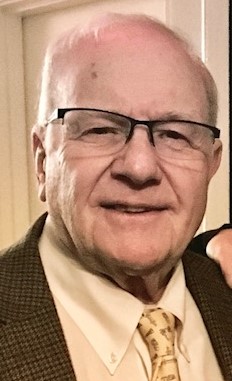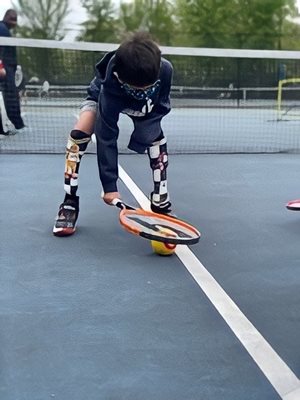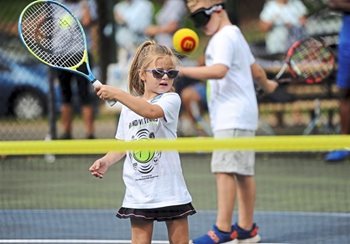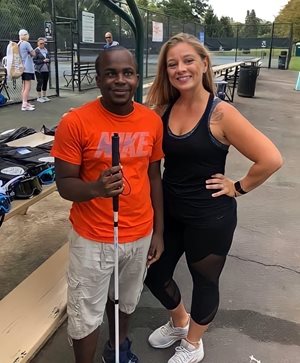 Richard Feldstein, OD ‘62, has been playing tennis for more than 75 years. Now he’d like to do what he can to help blind and visually impaired children learn the joys of participating in his beloved sport.
Richard Feldstein, OD ‘62, has been playing tennis for more than 75 years. Now he’d like to do what he can to help blind and visually impaired children learn the joys of participating in his beloved sport.
Dr. Feldstein offers his consulting expertise at the Highland Park Tennis Club in Pittsburgh, that offers a clinic teaching blind children and adults ages six to 80 to play tennis.
Not surprisingly, it’s no easy task and the idea is still evolving. Dr. Feldstein received a newsletter from the Western Pennsylvania School for the Blind and in it, there was a story about a company that had developed “beeping” Easter eggs designed for blind children to be able to participate in Easter Egg hunts.
Having been in conversation with the group running a blind tennis program, including ongoing experiments to improve the ball, a light went off in Dr. Feldstein’s head. He called the school and asked for the name of the company making the beeping Easter eggs. He wondered if the company could also develop chips that could be placed in tennis balls with different sounds at different ranges.
He forwarded that information to the tennis clinic coordinators at Highland Park Tennis Club, who had for years already been in the development stages of a ball that made sounds.
 “I looked into the beeping Easter eggs and they seemed to use a pure tone, which is impossible to localize,” said Jennifer Roth, PhD, associate professor of Psychology at Carlow University in Pittsburgh who is also a cognitive neuroscientist and one of the tennis club coordinators of the project. “We’ve been doing a from-the-ground-up science research study for months, conducting Fourier transforms (a mathematical transform that decomposes functions depending on spatial or temporal frequency) on sounds, then testing them on human subjects in their capacity to localize those sounds in space.”
“I looked into the beeping Easter eggs and they seemed to use a pure tone, which is impossible to localize,” said Jennifer Roth, PhD, associate professor of Psychology at Carlow University in Pittsburgh who is also a cognitive neuroscientist and one of the tennis club coordinators of the project. “We’ve been doing a from-the-ground-up science research study for months, conducting Fourier transforms (a mathematical transform that decomposes functions depending on spatial or temporal frequency) on sounds, then testing them on human subjects in their capacity to localize those sounds in space.”
This research project now runs in conjunction with the United States Tennis Association (USTA). Students in the clinics come from partnerships with regional non-profits serving blind and visually impaired athletes. The main partners the Highland Park Tennis Club uses for referrals are the Western Pennsylvania division of Blind Outdoor Leisure Development (BOLD) and EnVision Sports serving blind and visually impaired children. The club also advertises for referrals via the Blind and Vision Rehabilitation Services of Pittsburgh.
Blind tennis is played in 30 countries at the tournament level, but the U.S. is not included. So, part of the effort is the Highland Park Tennis Club (www.hptc.org) is helping plant new blind tennis clubs across the country. In addition to the Pittsburgh club, there are blind tennis clubs in Cincinnati, Ohio, New York City, North Carolina and McAllen, Texas.
Blind tennis players currently play with a mechanical rattle ball — some ball bearings inside of a hollowed golf ball that rattle when hit — that is inserted into a sponge ball.
The duration of the sound is identical across all players, according to Dr. Roth. A blind player is allowed more bounces before returning the ball and allowed to hit off the first or second bounce. In traditional tennis, the player has to hit the ball off of one bounce. A person who is profoundly blind gets three bounces. A person with a severe visual impairment receives two bounces. There are players who are visually impaired who play with a sound ball and only get one bounce.
 Students learn how to swing the rackets from listening to the sounds, although there are also different sizes of rackets used by the students. The functional players are divided into four groups based on the visual ability of the students. One of the goals is to have the students hit the ball so it comes back a second time.
Students learn how to swing the rackets from listening to the sounds, although there are also different sizes of rackets used by the students. The functional players are divided into four groups based on the visual ability of the students. One of the goals is to have the students hit the ball so it comes back a second time.
“It’s teaching the students to listen to the sound. It’s technical in that the ratings go in a classification from B1 to B4. The format adapts the sport to the different visual acuities with certain ratings so B1 players are classified as profoundly blind whereas players B2-B4 are classified as visually impaired,” said Dr. Feldstein. “They use a smaller court and they have to try to put together the strike of the ball and the sound.”
The International Blind Tennis Association develops and maintains the classification standards for the athletes. In addition, the Highland Park Tennis Club recently received a grant from the USTA and the two groups are working in partnership on a ball development project for blind tennis players.
Dr. Feldstein is a second-generation optometrist from the Pennsylvania College of Optometry (PCO) at Salus University. His father, Charles Feldstein, OD ‘30, was among the first decade of graduates from what was then titled the Pennsylvania State College of Optometry (PSCO).
 Dr. Feldstein initially wanted to be a football coach and attended Miami University in Ohio, what Dr. Feldstein called “the cradle of coaches.”
Dr. Feldstein initially wanted to be a football coach and attended Miami University in Ohio, what Dr. Feldstein called “the cradle of coaches.”
“But I thought to myself, ‘How many football coaches made a lot of money in 1958?’ Not a whole lot,” said Dr. Feldstein. “I saw what my father did and I enjoy people, so I tried optometry.”
At the age of 83, Dr. Feldstein is still practicing and still enjoys seeing patients. And, he’s still playing tennis while trying to help the next generation of blind and visually impaired children.
“I’m not in low vision, I’m just involved because of my tennis,” said Dr. Feldstein, who anticipates that tennis clinics for the blind are going to continue to grow in the U.S. “The clinics give the children exercise, they’re outside and communicating with other children. And, the parents are there helping them.”